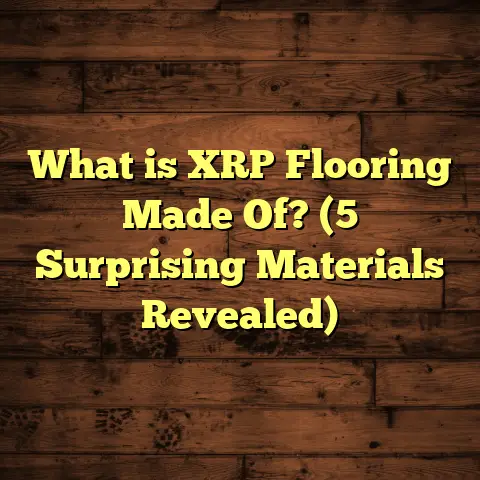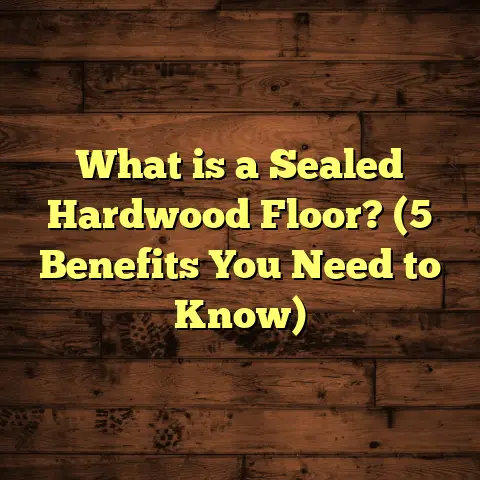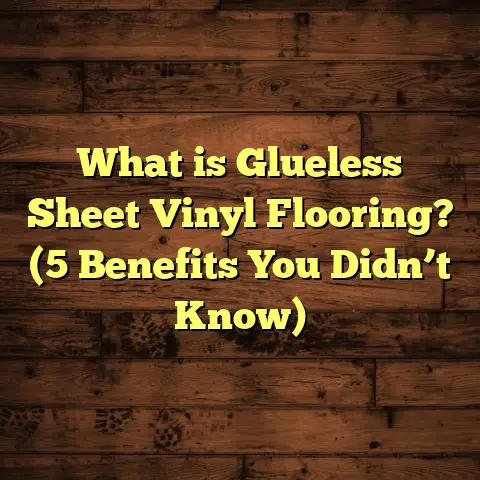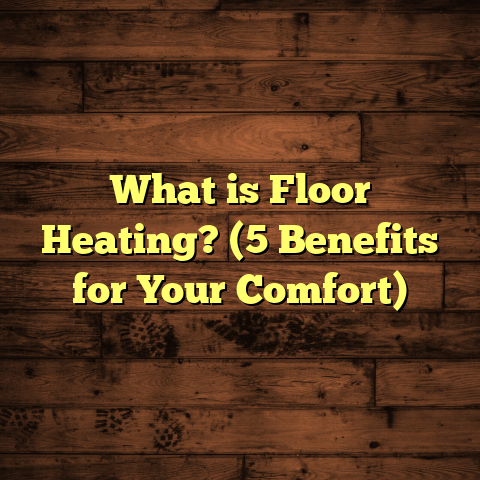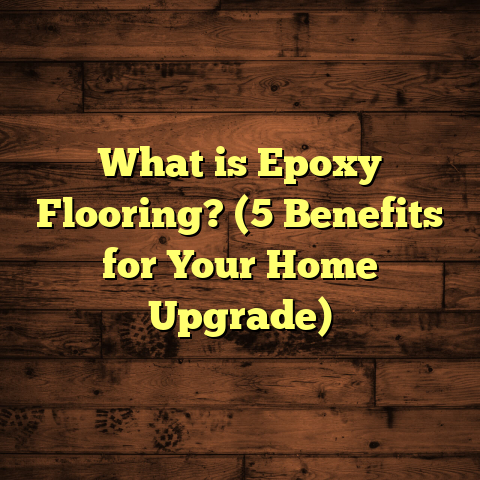What Is Fake Hardwood Floor Called? (5 Types You Should Know)
Safety is the first thing I think about whenever I step into a home or start planning a flooring job. Floors might seem like a purely aesthetic choice, but they’re much more than that. They need to be safe underfoot—meaning they shouldn’t be slippery, shouldn’t warp or buckle unexpectedly, and should resist wear and tear that could cause splinters or other hazards. When you’re considering hardwood flooring, you might hear about “fake hardwood” floors. These are flooring options that look like solid wood but aren’t quite the same. What exactly are these floors called? Are they safe? How do they compare to real hardwood? I want to walk you through everything I’ve learned over the years working with these materials.
What Is Fake Hardwood Floor Called?
Fake hardwood floors are flooring products designed to imitate the natural beauty of hardwood floors but are made from alternative materials or constructed using different methods. The term “fake hardwood” is often used informally, but in the industry, these floors have specific names and categories based on their material composition and manufacturing process.
Broadly speaking, these include:
- Engineered Hardwood Flooring
- Laminate Flooring
- Luxury Vinyl Plank (LVP) Flooring
- Vinyl Composite Tile (VCT) with Wood Look
- Wood Plastic Composite (WPC) Flooring
Each type has distinct characteristics, advantages, and weaknesses. Not every option suits every environment or budget. Let me break down what each one means, how it’s made, and when it’s appropriate.
Engineered Hardwood Flooring
Engineered hardwood is the closest “fake” hardwood floor to real hardwood because it actually contains a thin veneer of real wood on top. The difference lies in the core beneath this veneer.
How It’s Made:
Engineered hardwood is created by layering multiple thin sheets of wood together to form a core, often plywood or high-density fiberboard (HDF). The grain of each layer is arranged perpendicularly to the adjacent one. This cross-grain construction adds strength and minimizes expansion or contraction caused by humidity changes.
The top layer is a thin slice of genuine hardwood—usually between 1 mm to 4 mm thick—bonded to the core with industrial adhesives under heat and pressure.
This manufacturing technique is called plywood lamination or multi-ply construction. It results in a floor that looks like solid wood but is more stable and less prone to warping.
Technical specifications:
- Thickness ranges from 3/8 inch (9.5 mm) to 3/4 inch (19 mm).
- Veneer thickness affects how many times you can sand and refinish the floor.
- Installation methods vary: nailed down, stapled, glued, or floated.
- Engineered hardwood usually carries a finish factory-applied polyurethane or aluminum oxide coating for durability.
Why choose engineered hardwood?
I recommend engineered hardwood for rooms where you want the warmth and elegance of real wood but need better moisture resistance—like kitchens or basements with proper subfloor preparation.
Personal experience: When I remodeled my own kitchen, I chose engineered hardwood because it handled steam and occasional water spills much better than solid wood would. Even after three years of heavy cooking and foot traffic, it still looks beautiful.
Durability: While engineered floors can be sanded a few times depending on veneer thickness, they generally don’t last as long as solid hardwood floors in terms of refinishing potential. Still, their resistance to humidity fluctuations often makes them last longer in challenging environments.
Laminate Flooring
Laminate flooring is often confused with engineered hardwood, but it’s an entirely different product. It has no real wood on the surface but instead uses photographic technology to mimic wood grain.
How laminate is made:
Laminate consists of several layers:
- Wear layer: A clear melamine resin layer protects against scratches and stains.
- Design layer: A high-resolution photographic image of real wood grain printed on decorative paper.
- Core layer: High-density fiberboard (HDF) made from compressed wood fibers bonded with resin.
- Backing layer: A melamine resin base to provide moisture resistance and stability.
These layers are fused under heat and pressure in a process called high-pressure lamination (HPL).
Key Features:
- Thickness usually ranges from 7 mm to 12 mm.
- Most laminate floors have a click-lock installation system for floating installations—meaning no nails or glue are needed.
- Surface finishes can vary; some have embossed textures that mimic the feel of real wood grain.
Why laminate?
Laminate flooring is popular because it’s affordable, easy to install, and fairly durable against scratches and dents. It’s great for high-traffic areas like hallways or family rooms where you expect wear but don’t want to spend a ton on flooring.
Limitations:
Water damage is laminate’s Achilles heel. The HDF core swells if exposed to moisture for extended periods. That’s why it’s not ideal for bathrooms or basements unless special water-resistant products are chosen.
Market data: According to recent industry reports, laminate flooring accounts for roughly 35% of residential flooring sales in North America due to its price point and installation ease.
My take: I installed laminate in a client’s playroom where kids often spilled juice or dropped toys. It held up well for over five years with minimal wear despite heavy use. But I always warn clients to clean spills quickly to avoid swelling.
Luxury Vinyl Plank (LVP)
Luxury Vinyl Plank flooring has surged in popularity over the past decade, becoming the go-to choice for many homeowners wanting waterproof floors that look like hardwood.
What makes LVP special?
LVP is composed primarily of vinyl but designed to replicate the look and texture of wood planks through advanced printing techniques and embossing. It often features realistic knots, grains, and even distress marks.
Manufacturing process:
LVP consists of multiple layers:
- Wear layer: A clear coat of polyurethane or aluminum oxide provides scratch and stain resistance.
- Printed vinyl layer: Contains high-resolution wood grain patterns.
- Core layer: Can be flexible vinyl (PVC) or rigid core made from wood-plastic composite (WPC) or stone-plastic composite (SPC).
- Backing layer: Provides sound absorption and cushioning; sometimes cork-backed for extra comfort.
Thickness: Typically ranges from 2 mm (thin) up to 8 mm or more for rigid core varieties.
Waterproof qualities: LVP is completely waterproof because vinyl doesn’t absorb moisture. This makes it suitable for bathrooms, basements, kitchens—anywhere water exposure is common.
Installation methods:
- Floating click-lock systems dominate for DIY ease.
- Glue-down options exist for commercial settings requiring extra stability.
Durability: LVP scores high on scratch resistance and doesn’t dent easily. It stays comfortable underfoot thanks to its softer core compared to tile or stone.
I once installed LVP in a client’s basement gym where moisture was a constant concern. The client loved how easy it was to clean sweat and dust off without worrying about damaging the floor.
Vinyl Composite Tile (VCT) With Wood Look
Vinyl Composite Tile has been around for decades, mostly in commercial environments like schools and hospitals because of its durability and cost-effectiveness.
What about wood-look VCT?
Manufacturers can create wood designs on VCT using coloring techniques embedded during production. However, VCT doesn’t mimic wood grain texture as realistically as LVP or laminate.
Construction:
VCT is made by blending colored vinyl chips compressed into solid sheets or tiles. The surface is usually smooth but requires regular waxing and polishing for shine.
Usage:
Because VCT is very durable but less realistic-looking than other options, it’s typically found in places where function outweighs appearance.
Maintenance:
I’ve installed VCT in retail spaces where heavy foot traffic demands tough floors. The tradeoff is frequent waxing to keep them looking their best, which can be labor-intensive.
Wood Plastic Composite (WPC) Flooring
WPC blends wood fibers or flour with plastic materials like PVC to create a composite core for vinyl planks.
How WPC differs from LVP:
While LVP’s core can be flexible vinyl, WPC has a rigid core that includes wood fibers for added density and stability. This gives WPC slightly better insulation and comfort underfoot compared to standard LVP.
Manufacturing highlights:
- Combination of recycled wood flour and plastic resin
- Extrusion process creates planks with uniform thickness
- Top wear layer similar to LVP with UV-cured coatings
Because of its composite core, WPC resists dents better than flexible vinyl planks but remains waterproof.
I’ve installed WPC in several homes in humid climates where laminate failed due to moisture damage. Clients appreciated the cushioned feel combined with durability.
Comparing These Fake Hardwood Floors Side-by-Side
You might ask: “How do I pick which fake hardwood floor fits me best?” Let me share some practical insights based on my experience.
| Flooring Type | Appearance Realism | Moisture Resistance | Installation Ease | Durability | Cost Range per sq.ft Installed | Best Use Cases |
|---|---|---|---|---|---|---|
| Engineered Hardwood | Very High | Moderate | Moderate | High | $7 – $12 | Living rooms, kitchens |
| Laminate | High | Low | Easy | Moderate | $2 – $6 | Playrooms, hallways |
| Luxury Vinyl Plank | Very High | Very High | Easy | Very High | $3 – $7 | Kitchens, basements, bathrooms |
| Vinyl Composite Tile | Moderate | Very High | Moderate | High | $1 – $4 | Commercial spaces |
| Wood Plastic Composite | High | Very High | Easy | High | $4 – $8 | Humid areas, basements |
Cost & Installation Thoughts — How FloorTally Helps Me
When I’m budgeting flooring projects for clients or even my own home upgrades, accuracy matters hugely. Underestimating materials or labor can blow budgets fast. Overestimating wastes money on leftover stock.
FloorTally has been invaluable in my workflow. It allows me to input room dimensions and select flooring type while factoring local labor rates. The tool adjusts for waste material percentages based on flooring type—critical because cut-offs add up quickly.
For example:
- Engineered hardwood typically requires 5-10% extra material for waste.
- Laminate floors may need around 7% waste due to plank cutting.
- LVP waste varies but generally stays near 5%.
FloorTally calculates these automatically so I don’t have to guess.
It also helps me visualize total costs broken down by labor vs material—which helps clients understand where their money goes. This transparency speeds up decision-making and builds trust.
Manufacturing Insights Deeper Dive
I love understanding how things are made because it helps me troubleshoot problems in the field.
Engineered Hardwood Detailed Manufacturing
The plywood core layers are assembled with alternating grain directions—a technique borrowed from traditional plywood manufacturing—to resist dimensional changes caused by humidity swings. Adhesives used today must meet strict environmental standards (low VOCs).
After layering, the boards are pressed under intense heat (<del>120°C) and pressure (</del>300 psi), bonding layers into a single plank that can be milled into tongue-and-groove edges before applying finishes.
The veneer slicing process itself is fascinating; logs are rotary peeled or sliced into extremely thin sheets—some less than 1 mm thick—to maximize yield without sacrificing surface quality.
Laminate Flooring Manufacturing
Laminate production lines operate continuously:
- Decorative paper printed with high-resolution images runs alongside overlay paper saturated with melamine resin.
- These papers are stacked on top of an HDF core board.
- The full assembly passes through a press where heat (<del>150°C) and pressure (</del>1000 psi) cure the resin layers into a hard surface bonded tightly to the core.
Laminate edges are precision cut post-lamination to achieve perfect fitting planks with bevels mimicking real wood joints visually.
Luxury Vinyl Plank Production
LVP manufacturing involves extrusion of vinyl resin mixed with plasticizers into sheets or planks. UV printers apply detailed images directly onto vinyl surfaces with embossing added mechanically or chemically afterward for texture realism.
Rigid cores like SPC use mineral fillers such as limestone powder mixed with PVC to create very dense planks resistant to dents and temperature changes.
Real-Life Stories From My Flooring Jobs
I remember one job vividly where a customer wanted “wood floors” in their basement rec room but was worried about moisture damage from occasional flooding during heavy rains.
I recommended luxury vinyl plank flooring because it offered waterproof properties without sacrificing style. After installation, they told me it looked so natural that guests thought it was real hardwood—and they never had water damage issues even after a pipe leak flooded part of the basement.
Another time, a couple wanted budget-friendly flooring that looked good but could handle their two energetic dogs scratching away at floors daily. Laminate was my recommendation because its wear layer resisted scratches better than many engineered hardwood finishes at lower cost. They were happy with how well it held up after two years despite pet traffic.
Environmental & Health Considerations
You might wonder about safety beyond just physical durability—like indoor air quality or eco-friendliness?
VOCs & Emissions
All synthetic flooring materials release volatile organic compounds (VOCs) at some level initially after installation. However modern engineered hardwoods use low-VOC adhesives; laminates often carry certifications like FloorScore; luxury vinyl manufacturers offer phthalate-free options.
In my projects, I always specify products certified by organizations such as GREENGUARD or CARB Phase 2 compliance to ensure healthier indoor air quality.
Sustainability
Engineered hardwood uses less precious natural wood since only a thin veneer layer is needed compared to solid planks. Some brands source veneers from sustainably managed forests certified by FSC (Forest Stewardship Council).
Vinyl products have recycling challenges but newer recycling programs are emerging in some regions aiming to reduce landfill waste from old vinyl planks.
Maintenance Tips for Fake Hardwood Floors
Each flooring type demands different care:
- Engineered Hardwood: Clean regularly using damp mop with pH-neutral cleaners; avoid excess water; refinish when wear becomes visible.
- Laminate: Sweep often; wipe spills immediately; no waxing or polishing.
- Luxury Vinyl Plank: Mop with mild detergent; avoid abrasive cleaners; wax-free.
- Vinyl Composite Tile: Requires frequent waxing/polishing; strip & reseal periodically.
- WPC Flooring: Similar care as LVP; gentle cleaners recommended.
Common Issues & How I Fix Them
Some typical problems I see:
- Engineered Hardwood Cupping: Usually caused by moisture imbalance beneath floor—fix by improving subfloor ventilation.
- Laminate Swelling: Happens when water seeps into seams—seal edges better next time or switch to waterproof alternatives.
- LVP Scratches: Rare but possible—use furniture pads; repair kits can fill minor scratches.
- VCT Dulling: Re-waxing restores shine but requires professional maintenance regularly.
Knowing these issues upfront helps me counsel clients on realistic expectations based on lifestyle and location conditions.
Final Thoughts From My Experience
Fake hardwood floors offer flexibility across budgets and environments without sacrificing style. Whether you want the authentic touch of engineered wood or the practicality of waterproof luxury vinyl plank, there’s something out there that fits your needs perfectly.
Ask yourself:
- Do you want real wood feel or just the look?
- What’s your budget?
- How much moisture exposure will your floor face?
- How important is DIY installation versus hiring pros?
With answers clear in mind, picking your fake hardwood floor becomes straightforward—not stressful.
If cost estimation worries you like it did me early on, use tools like FloorTally for quick accurate budgeting—they saved me time juggling quotes from multiple suppliers!
Have questions about installation processes? Curious about which finishes last longest? Just ask—I’m here to share what I’ve learned through years on job sites and personal projects alike!
If you’d like me to break down any section further or add specific technical details such as adhesive types used in engineered floors or life expectancy comparisons backed by studies, just say so!
